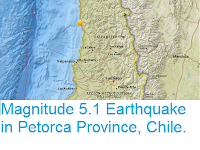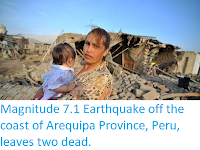At least eleven people have died as heavy rains hit southern Peru and northern Chile this week. Three people are know to have died and several more are still missing after two separate mudslides hit towns in the Arequipa Province of Peru, and another two when a similar incident hit a mine in Palpa District. Landslides
are a common problem after severe weather events, as excess pore water
pressure can overcome cohesion in soil and sediments, allowing them to
flow like liquids. Approximately 90% of all landslides are caused by
heavy rainfall. In Chile has cause a series of flash floods in the Atacama Desert, normally considered one of the driest places on Earth, destroying over a hundred homes and killing at least six people. Like many desert areas the Atacama, while generally arid, is
prone to occasional severe flooding. This stems from two causes; firstly
the arid climate prevents the development of a thick soil layer which
would be expected in less dry areas, so that in much of the area
(non-porous) bedrock is either exposed or close to the surface, and
secondly the hot climate leads to heavy evaporation from nearby Pacific Ocean, so that if the wind changes direction and brings water-laden
air to the area, it brings a lot of precipitation with it. This
combination of heavy rainfall and low ground absorbency leads to large
amounts of water at the surface, typically moving downhill at some
speed. Dry channels or ravines through which these sudden floods
are channelled, can be particularly dangerous at these times,
particularly as they often appear to resemble natural pathways or even
camp sites to people unfamiliar with the climate.
A car trapped in mud following a flash flood at Chuquicamata in the Atacama Desert of northern Chile. Pedro Tapia/AFP.
This extreme weather has been linked to a developing El Niño wearther system over the Pacific Ocean. The
El Niño is the warm phase of a long-term climatic oscillation affecting
the southern Pacific, which can influence the climate around the world.
The onset of El Niño conditions is marked by a sharp rise in
temperature and pressure over the southern Indian Ocean, which then
moves eastward over the southern Pacific. This pulls rainfall with it,
leading to higher rainfall over the Pacific and lower rainfall over
South Asia. This reduced rainfall during the already hot and dry summer
leads to soaring temperatures in southern Asia, followed by a rise in
rainfall that often causes flooding in the Americas and sometimes
Africa. Worryingly climatic predictions for the next century suggest
that global warming could lead to more frequent and severe El Niño
conditions, extreme weather conditions a common occurrence.
Movements of air masses and changes in precipitation in an El Niño weather system. Fiona Martin/NOAA.
See also...
Follow Sciency Thoughts on Facebook.








